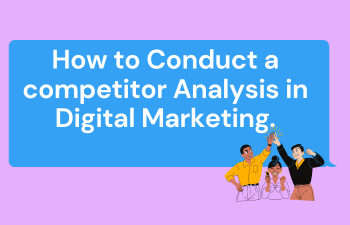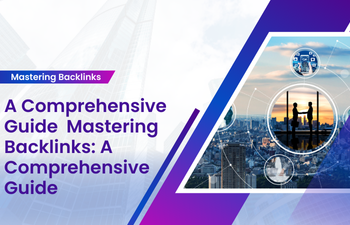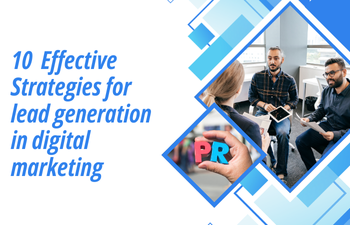Mastering Backlinks: A Comprehensive Guide to Boosting SEO, Lead Generation, and Online Success
Table of Contents
What exactly is a backlink?
What are the types of Backlinks?
What is the significance of backlinks in SEO?
How do backlinks aid in lead generation?
What constitutes a high-quality backlink?
What are the typical back linking blunders to avoid?
How to detect and eliminate toxic backlinks?
Conclusion
What exactly is a backlink?
A backlink is a hyperlink that takes users to another domain’s website. Backlinks are crucial for search engine optimization (SEO) since they indicate the trustworthiness and authority of a website. Backlinks from credible sites are more helpful and relevant to users, resulting in higher search rankings. However, not all backlinks are created equal, and the linked site’s quality, relevance, and authority all play a role in deciding their worth. Obtaining high-quality backlinks using legal ways, such as providing valuable content, guest posting, and connection building, is a frequent SEO strategy for increasing a website’s visibility and ranking. Avoiding spammy or manipulative practices might result in fines and hinder the SEO efforts of a website.
What are the types of Backlinks?
Backlinks are classified into several sorts based on a variety of characteristics such as the source of the connection and the nature of the linking relationship. Here are some examples of common sorts of backlinks:
Natural backlinks are organic links that are produced without the connected website’s conscious effort. When other websites find your content good and relevant, they may naturally connect to it, showing that it is useful and trustworthy.
Editorial Backlinks: Editorial backlinks are links that the website’s editorial team includes into the content of a webpage. These links are often offered to improve the reader’s experience by directing them to relevant and useful resources.
Backlinks from Guest Posts: When you contribute a guest post or article to another website, you may frequently incorporate a link to your own website in the author bio or text. These are referred to as guest post backlinks.
Backlinks to your business profile: Websites that display your company’s information, such as online directories, review sites, or local business listings, may add a link to your website. These are referred to as business profile backlinks.
Backlinks in Forum Signatures: Some online forums permit users to post a link to their website in their forum signature. These are known as forum signature backlinks.
Comment Backlinks: Comment backlinks are created when individuals leave comments on blog posts or articles and include a link to their website. It’s worth noting, though, that many websites add a “no follow” property to comment URLs in order to deter spam.
Backlinks from Resource Pages: A resource page backlink occurs when your website is listed on a resource page that curates relevant links relating to a specific topic.
Social media backlinks are links to your website that are posted on social media sites such as Facebook, Twitter, LinkedIn, and others.
Paid backlinks are links obtained by payment or some other type of compensation. However, search engines such as Google oppose the buying and selling of links, and breaking their rules can result in fines.
Image and Info graphic Backlinks: Image and info graphic backlinks are created when other websites use your images or info graphics and link back to the original source.
Remember that the quality and relevance of backlinks are more important than the mere number. Backlinks from authoritative and relevant sources have a greater impact on SEO and organic search rankings. It is critical to concentrate on developing a natural and diversified backlink profile while avoiding any manipulative practices that contradict search engine standards.
What is the significance of backlinks in SEO?
Backlinks are important in Search Engine Optimization (SEO) because they affect a website’s visibility and ranking in search engine results. Backlinks have the following impact on SEO:
Backlinks are regarded by search engines as votes of confidence in their authority and credibility. When other credible and authoritative websites link to your material, search engines recognize that your website is valuable, trustworthy, and deserving of higher rankings in search results.
Improved Search Engine Rankings: Websites having a wide and strong backlink profile are more likely to rank higher in search engine results pages (SERPs). Backlinks are one of the most important indicators that search engines use when determining the relevance and authority of a webpage for a certain search query.
Backlinks from other websites can aid search engine crawlers in more efficiently discovering and indexing your material. It functions as a trail for search engine bots to follow to your website’s pages.
Backlinks bring direct traffic to your website as well as referral traffic. Users are sent to your site when they click on a link from another site, boosting the possibility of new visits and possible sales.
Anchor Text Optimization: The anchor text (the clickable text in a hyperlink) used in a backlink can give search engines with additional context and relevancy signals. Optimizing anchor text with relevant keywords can help your site rank for certain keywords.
Backlinks transmit “link juice” or “PageRank” to the linked webpage. Search engines utilize link juice as a ranking component to estimate the significance of a page. The more high-quality backlinks a page obtains, the more link juice it gathers, potentially helping it rank higher.
Building high-quality backlinks might provide you with a competitive advantage over other websites in the same niche. Your site is more likely to outrank other websites in search results if it has better and more authoritative backlinks.
Indexing Deep Pages: Backlinks help not just your homepage but also the indexing and ranking of your website’s deeper pages. When other websites link to specific pages on your site, their chances of getting discovered and rated rise.
Backlinks are not always advantageous to SEO; low-quality, spammy, or manipulative links might affect your site’s rankings. Focus on gaining natural, high-quality backlinks from reliable sources through creating content, building relationships, and providing value to users.

How do backlinks aid in lead generation?
Backlinks can also be useful in generating leads for businesses. Backlinks can generate targeted traffic to your website, boost brand visibility, and attract new clients who are interested in your products or services when used carefully. Backlinks can help with lead creation in the following ways:
Increased Website Traffic: Backlinks from authoritative and relevant websites might attract more traffic to your website. Users who click on these links are sent to your website, potentially boosting the number of individuals who learn about your company and its offers.
Backlinks from websites in your sector or business can bring users who are already interested in similar items or services to yours. These are more likely to be qualified leads because they are more likely to convert into customers.
Increased Brand Visibility: When your website is linked from other credible sites, it boosts the visibility of your brand. More individuals become acquainted with your company as a result of backlinks, which can lead to increased brand awareness and trust.
Positive SEO Signals: As previously said, search engines regard backlinks as votes of trust and authority. When your website gains high-quality backlinks, search engines receive favorable signals, potentially enhancing your organic search ranks. Higher rankings result in increased visibility and traffic, which contributes to lead generation.
Building backlinks frequently entails reaching out to other website owners and developing relationships. This procedure can result in important networking opportunities and prospective partnerships with other businesses in your field, perhaps opening up new lead generating channels.
Guest posting and content marketing: As part of your backlink strategy, you may promote yourself as an industry authority by creating quality material for other websites. This expertise has the ability to attract leads that are looking for useful information and solutions, potentially converting them into customers.
Amplification on Social Media: Backlinks from high-traffic websites may result in social media shares and mentions. This will magnify your content and boost your chances of reaching a larger audience, including potential leads.
Focus on gaining authoritative websites, generating excellent content, guest posting on respectable websites, consistently monitoring your profile, and utilizing social media and email marketing to maximize backlinks for lead creation. Content marketing, social media marketing, email marketing, and paid advertising are all examples of comprehensive lead generation strategies.
What constitutes a high-quality backlink?
A quality backlink is one that has certain important characteristics that are beneficial to SEO and the authority and rankings of your website.
Relevance, authority, trust, natural and organic, contextual, diverse link profile, anchor text optimization, editorial placement, traffic potential, no spam or low-quality sites, and regular and natural growth are among these characteristics.
Relevant backlinks come from credible websites with a significant online presence, whereas contextual backlinks are placed inside the content of a webpage.
A diverse link profile communicates the importance of your content to different audiences and domains.
Anchor text optimization assists search engines in understanding the topic of the material.
Editorial placement ensures that your material is valued and relevant to your target audience without having to pay for it or exchange it for anything else. The potential for traffic enhances lead generation and conversions.
There will be no spam or low-quality sites, and regular and natural growth is required. Concentrate on producing useful and shareable content that will organically attract backlinks from reliable sites.
Engaging in ethical SEO practices and cultivating relationships with other website owners can assist you in obtaining high-quality backlinks that boost your website’s authority and SEO ranks.
Typical back linking blunders to avoid
Avoid frequent back linking blunders to boost your website’s SEO and develop a strong online presence. Avoid purchasing links, acquiring low-quality backlinks, over-optimizing anchor text, ignoring no follow links, ignoring link relevance, building links too quickly, taking website quality into account, ignoring anchor text diversity, ignoring broken links, ignoring content quality, and monitoring your backlink profile.
You may boost your site’s SEO results and develop a strong online presence by avoiding these blunders. You may increase your website’s ranks and develop a strong online presence by focusing on generating valuable content, earning natural backlinks from credible sources, and avoiding manipulative practices that violate search engine guidelines.
Checking for and eliminating harmful backlinks is an important element of keeping a healthy backlink profile and safeguarding your website against any SEO penalties. Here is a step-by-step guide to identifying and removing hazardous backlinks:
How to detect and eliminate toxic backlinks?
Utilize the Google Search Console (GSC):
Log in to your Google Search Console account and navigate to your website’s property.
To see a list of websites that link to your site, go to “Links” > “External Links.”
Examine the Backlink Quality:
Examine the list of domains that are linked. Look for websites that are spammy, irrelevant, or have a negative reputation.
Pay attention to websites that have a poor domain authority, a high spam score, or content that is unrelated to your site.
Use Backlink Analysis Software:
To acquire a more complete picture of your backlink profile, use third-party backlink research tools such as Ahrefs, Moz, SEMrush, or Majestic.
These tools give you more information about backlink quality, anchor text dispersion, and general link health.
Examine for Link Penalties:
Check to see whether your website has earned any Google manual actions or penalties as a result of unnatural or spammy backlinks. This information is available in GSC under the heading “Manual Actions.”
Make a Toxic Backlinks List:
Make a list of the hazardous backlinks that you discovered during the analyzing process.
Owners of Websites:
Contact the webmasters of the websites that have poisonous backlinks. Request that the links be removed from their website.
Be respectful and specific in your request, describing the harmful links and their locations on their website.
Remove Toxic Backlinks:
If you are unable to manually remove the poisonous backlinks, generate a disavow file. Make a list of all the harmful domains or URLs that you want to disavow.
Google Search Console should receive the disavow file. This instructs Google to disregard those links when evaluating your site’s backlink profile.
Keep an eye on your backlink profile:
Check your backlink profile on a regular basis to guarantee that no new dangerous backlinks appear.
Monitor your site’s performance in search results on a regular basis to look for any negative effects.
It is critical to approach the elimination of hazardous backlinks with caution. Only disavow links that you truly believe are detrimental to your website’s SEO. Too many unrelated or benign links disavowed might potentially hurt your site’s authority and rankings. Use this approach sparingly and instead concentrate on generating high-quality backlinks using ethical SEO practices.
Conclusion:
Please contact us as our SEO professional is here to answer any questions you may have about backlinks and lead production.
We understand how to create leads as we are a leading web development and digital marketing agency committed to delivering exceptional solutions tailored to your unique needs. And we are masters at generating constant ROI for businesses.
We specialize in generating high-quality site traffic. We recognize that no two businesses are alike. As a result, we provide tailored solutions to each of our clients. UniqWebTech offers a complete range of web development and web design solutions that include e-commerce development, web application development, Word Press content management system and many more.
 Digital Marketing
Digital Marketing



















